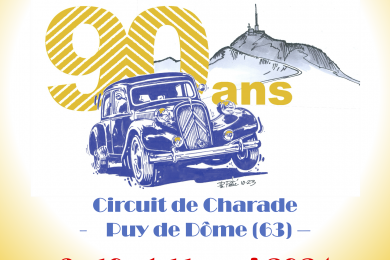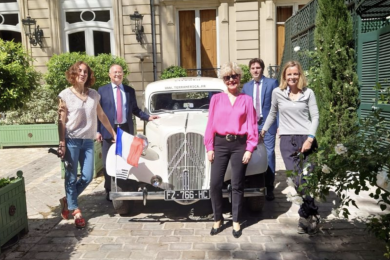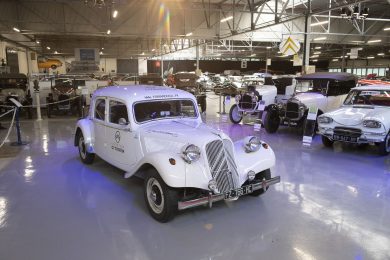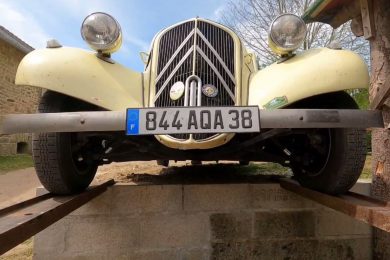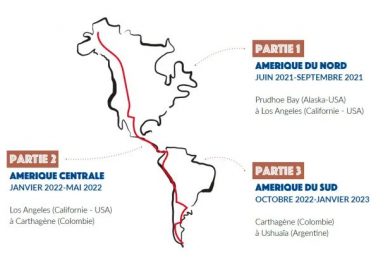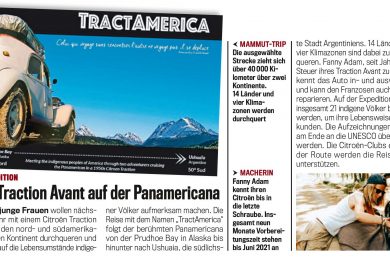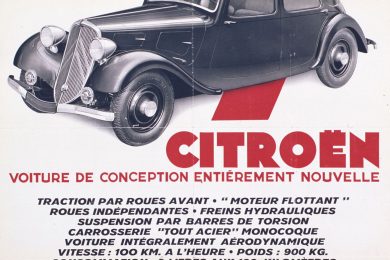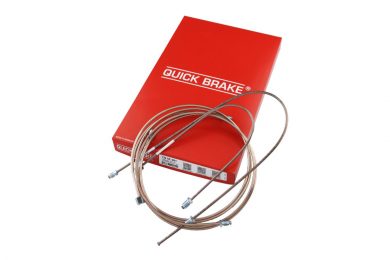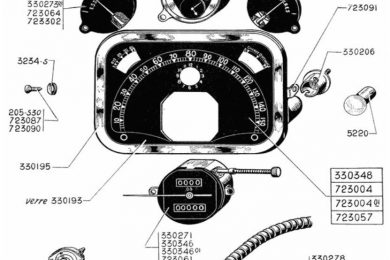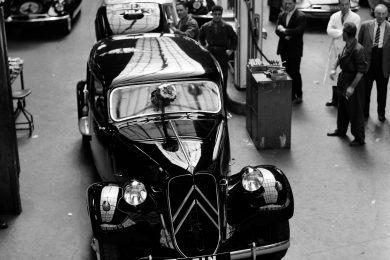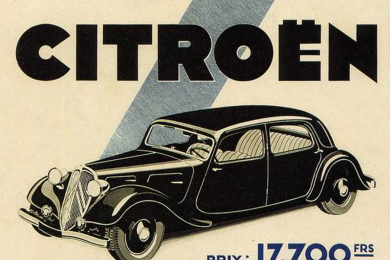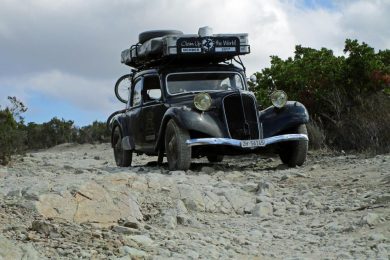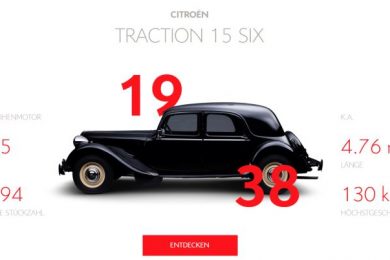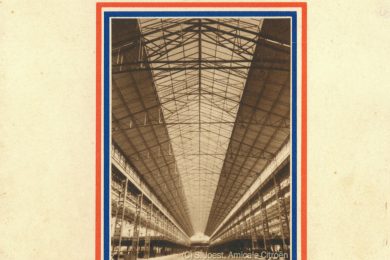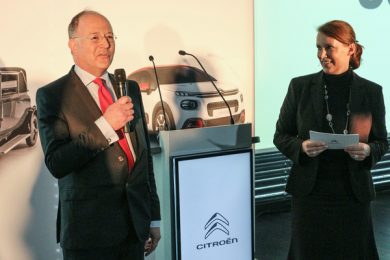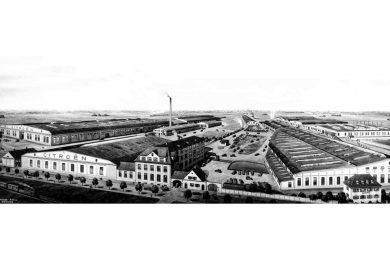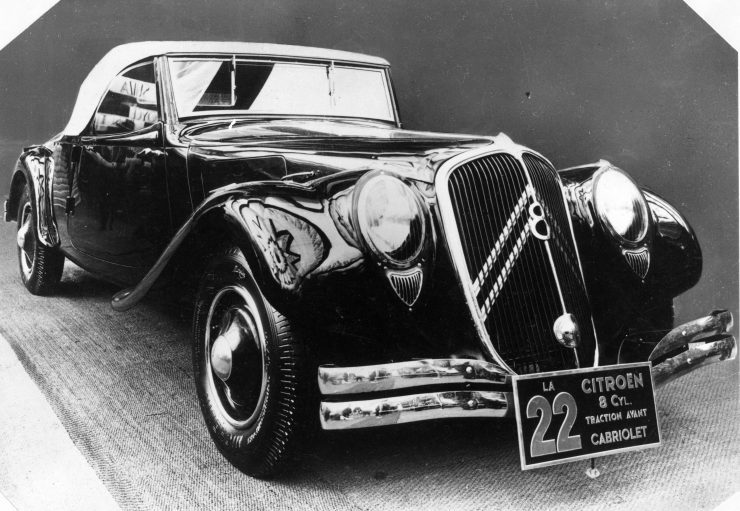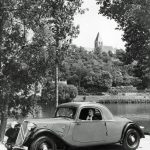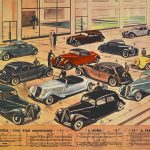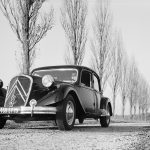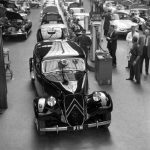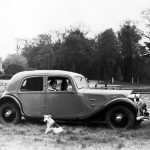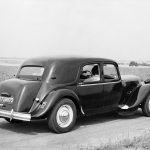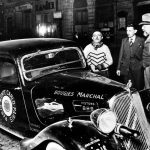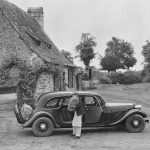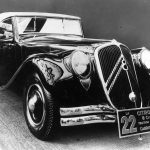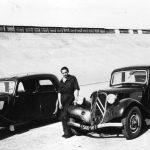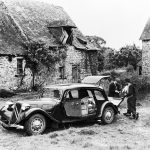(English below)
Die Pressemitteilung der internationalen Citroën Communications vom 25. April 2024:
**Das Auto mit 100 Patenten, wie es genannt wurde, kombinierte die modernsten Lösungen seiner Zeit. Neben dem Frontantrieb zeichnete es sich besonders durch eine Monocoque-Struktur, hydraulische Bremsen und eine unabhängige Federung an allen vier Rädern aus.
**Seine markante Silhouette, sofort erkennbar, hat mehrere Generationen fasziniert.
**Erstmals am 18. April 1934 als „7“ vorgestellt, erhielt es bald den Namen „Traction Avant“, der auf seine Art der Kraftübertragung hinweist.
**Ein echter Maßstab für Straßenlage und Komfort, setzte der Traction Avant ihre Produktion bis 1957 fort.
**Voller Innovationen inspiriert der Traction Avant die Marke nach wie vor sowohl in puncto Komfort als auch technischer Lösungen.
Die Traction Avant Revolution, das Auto mit 100 Patenten
Als Anfang 1933 beschlossen wurde, die Modelle Citroën 8, 10 und 15 zu ersetzen, die im Oktober 1932 eingeführt worden waren, strebte André Citroën danach, einen bedeutenden Einfluss zu erzielen und alle Konkurrenz zu überholen, indem er ein völlig revolutionäres Auto auf den Markt brachte. Sein Ziel war es, mindestens einen Vorsprung von zwei Jahren zu erlangen, um sich auch vor den Auswirkungen der Anfang der 1930er Jahre in ganz Europa spürbaren Weltwirtschaftskrise zu schützen. Dieses neue Auto sollte daher besonders bemerkenswert sein und eine maximale Anzahl technischer Innovationen zusammenführen.
Dazu gehörten eine Karosserie aus Ganzstahl, die die Notwendigkeit eines Fahrgestells beseitigte und den Schwerpunkt erheblich senkte, Frontantrieb, einen Zylinderkopfmotor mit herausnehmbaren Laufbuchsen, hydraulische Bremskontrolle, unabhängige Torsionsstabfederung an allen vier Rädern und ein automatisches Getriebe. Aufgrund des Zeitdrucks wurde jedoch das automatische Getriebe bei den ersten Serienmodellen von 1934 ausgelassen.
Neben diesen technischen Innovationen zeichnete sich der Chassis-lose Traction durch eine abgesenkte, aerodynamische Karosserie sowohl in seinen Linien als auch in ihrem flachen Boden aus. Schließlich ermöglichten sein kompaktes Motor- und Getriebeaggregat sowie sein sehr niedriger Schwerpunkt eine maximale Vorderlastverteilung. Die ersten Journalisten und Fahrer waren begeistert von dem neuen Citroën. Nie zuvor hatte ein Auto ein so sicheres und einfaches Fahren unter allen Bedingungen ermöglicht. Die Straßenlage setzte einen neuen Standard. Der Motor reagierte schnell, die Bremsen waren kraftvoll und die Sicherheit war makellos. Diese Qualitäten, ständig verbessert, wie die Übernahme der Zahnstangenlenkung im Juni 1936, sicherten dem Traction einen technischen Vorsprung gegenüber allen anderen Autos und führten zu einer glänzenden und außergewöhnlich langen Karriere, die erst im Juli 1957 endete.
Modelle und ihre Entwicklungen von 1934 bis 1957
Der 7, die erste der Traction
Das erste Modell des Traction, der 7 A, wurde am 18. April 1934 in Produktion genommen. Er hatte einen Vierzylindermotor mit einer Bohrung x Hub von 72 x 80 mm, einem Hubraum von 1.303 cm³ und 32 PS für 7 Steuer-PS. Es war das einzige wahre 7-Steuer-PS-Modell!
Der 7 B, sein Nachfolger, wurde im Juni desselben Jahres eingeführt. Sein neuer Motor hatte eine Bohrung x Hub von 78 x 80 mm, was den Hubraum auf 1.529 cm³ und die Leistung auf 35 PS mit einer steuerlichen Einstufung von 9 PS erhöhte. Der 7 B erreichte dann Geschwindigkeiten von 100 km/h.
Im Juli 1934 erschien eine Sportversion des 7 namens 7 S oder 7 Sport. Unter der Haube hatte er einen 1.910 cm³ Motor mit einer Bohrung x Hub von 78 x 100 mm, der 46 PS für 11 Steuer-PS entwickelte und eine Höchstgeschwindigkeit von 115 km/h ermöglichte.
Kurz vor dem Pariser Autosalon im September 1934 wurde der 7 B durch den 7 C ersetzt, dessen Motor weiterentwickelt wurde. Obwohl immer noch mit 9 steuerlichen Pferdestärken bewertet, stieg der Hubraum aufgrund einer Bohrung x Hub von 72 x 100 mm auf 1.628 cm³. Die tatsächliche Leistung betrug nun 36 PS und hielt eine Höchstgeschwindigkeit von 100 km/h aufrecht.
Schließlich erhielt der 7 C ab Februar 1939 einen neuen Motor namens 7 Economique, der den Kraftstoffverbrauch um zehn Prozent reduzierte.
Die Produktion des 7 endete im Frühjahr 1941.
Der 11 und seine lange Karriere
Der erste 11 erhielt den Namen 11 A und wurde im August 1934 eingeführt, einen Monat nach dem 7 S, mit dem gleichen 1.910 cm³, 78 x 100 mm Bohrung x Hub-Motor, der 46 PS für 11 Steuer-PS entwickelte. Äußerlich unterschied er sich von der 7 durch seine geräumigere Karosserie, die 12 cm breiter und 20 cm länger war.
Im Oktober 1934, auf dem Pariser Autosalon, ersetzte der 11 AL oder 11 Light den 7 S. Wie dieser wurde er aus einer 7 Karosserie und einem 11 CV-Motor gebaut, unterschied sich jedoch durch ein höheres Innen-finish-niveau des 11 A.
Die Modelle 11 B und 11 BL ersetzten im Februar 1937 die Modelle 11 A und 11 AL. Gleichzeitig wurde eine kleine Serie von etwa 500 Einheiten des 11, genannt 11 AM oder 11 „amelioré“ („verbessert“), mit einem speziellen Zylinderkopfmotor produziert.
Im April 1938 wurde eine Nutzfahrzeugversion der 11 unter dem Namen 11 C oder 11 Commerciale eingeführt. Mechanisch identisch mit dem 11, war es ein vielseitiges Fahrzeug, das je nach Bedarf als Tourist oder Nutzfahrzeug mit einer Nutzlast von 500 kg konfiguriert werden konnte. Er übernahm die Karosserie mit langem Radstand des „Familienautos“ („Familiale“) und erhielt eine zweiteilige Heckklappe zur erleichterten Beladung.
Ein neuer Motor namens 11 Performance wurde ab März 1939 in allen 11 Modellen eingebaut. Seine Leistung wurde von 46 PS auf 56 PS erhöht.
Die letzte Weiterentwicklung im Mai 1955: der 11 B, 11 BL und 11 C umfasste die Einführung eines neuen Motors namens 11 D, dessen Leistung auf 68 PS erhöht wurde und diejenigen der zukünftigen DS 19 und ID 19 vorausahnte.
Die Produktion des Modells 11 endete am 25. Juli 1957 im Javel-Werk. Er war der letzte der Traction-Baureihe. In etwas mehr als 23 Jahren wurden insgesamt 758.948 Einheiten aller Modelle produziert.
Das Modell 22, oder das Geheimnis von Javel
Von allen Traction-Modellen bleibt das angesehenste und bis heute rätselhafteste das 22er-Modell. Als High-End-Modell wurde es im Oktober 1934 auf dem Pariser Autosalon präsentiert. Es erhielt einen völlig neuen V8-OHV-Motor mit derselben 78 x 100 mm Bohrung x Hub wie der der 11. Sein Hubraum betrug 3.822 cm³ für eine Leistung von 100 PS und eine Höchstgeschwindigkeit von 140 km/h! Äußerlich zeichnete es sich durch aerodynamische Scheinwerfer, einen Kühlergrill mit der Zahl acht und halbblattüberlappende Stoßstangen aus. Es wurden nur etwa zwanzig Testeinheiten produziert, aber trotz verschiedener Gerüchte und der leidenschaftlichen Forschung von Sammlern und Historikern scheinen alle endgültig verschwunden zu sein…
Die 15, die Königin der Straße
Nachdem die Projekte für den 22 verworfen worden waren, plante Citroën weiterhin die Vermarktung einer High-End-Traction und brachte im Oktober 1938 den 15 Six auf den Markt. Dieses neue Modell erhielt einen brandneuen Reihensechszylinder-Motor mit 2.867 cm³ Hubraum, der 77 PS für 16 Steuer-PS lieferte. Es hatte die eigentümliche Eigenschaft, sich nach links zu drehen, was dem neuen Modell die Bezeichnung 15 Six G einbrachte. Der 15 Six bot die gleiche äußere Präsentation wie der 11 B; ihre Karosserien waren in dieser Hinsicht identisch. Der längere Motor erforderte jedoch eine um 11 cm verlängerte Motorhaube, was ihm eine unverwechselbare Persönlichkeit verlieh. Kraftvoll und leise, mit außergewöhnlichen Straßen- und Komforteigenschaften ausgestattet, erhielt es schnell den Spitznamen „Königin der Straße“. Im September 1947 wurde die Drehrichtung seines Motors umgekehrt, und der 15 Six D folgte dem 15 Six G. Der 15 Six erlangte nach dem Krieg Erfolg und etablierte sich als das französische High-End-Auto bis hin zur Spitze des Staates, wo es einen wahren Kultstatus erlangte. Im Mai 1954 wurde ein neuer 15 Six auf den Markt gebracht, der 6 H, der insbesondere auf der Hinterachse mit einer konstanten Höhen-Hydro-Pneumatik-Federung ausgestattet war. Dies war nichts anderes als die revolutionäre Federung, die fast anderthalb Jahre später die DS 19 ausrüsten würde. Die Einführung dieser neuen Königin von Javel im Oktober 1955 beendete dann endgültig die Vermarktung des 15 Six.
Ein Auto und mehrere Karosserien
Als der 7 im Jahr 1934 eingeführt wurde, war er als Viertürer-Limousine erhältlich, aber auch als Coupé (oder Schein-Convertible) und als Cabriolet mit klappbarer Windschutzscheibe (oder Roadster). Als der 11 wenige Monate später erschien, wurde er wiederum als Limousine, Coupé und Cabriolet angeboten, aber auch als Langkarosserie mit sechs Fenstern, konfiguriert entweder als 7-9 Sitzer Familienauto, Taxi oder 5-6 Sitzer Limousine, sowie als Langkarosserie mit vier Fenstern, konfiguriert als 5-Sitzer Stadtcoupé. Ab April 1938 war der 11 auch als kommerzielle Misch-Nutzfahrzeug-Tourismus-Version mit 5 Sitzen oder 500 kg Nutzlast erhältlich. Die Produktion der 7 und 11 Coupés endete im September 1938, während die der 7 und 11 Cabriolets im November 1939 endete. Als der 15 Six im Oktober 1938 auf den Markt kam, war er als 5-6 Sitzer Limousine erhältlich, und erst im Mai 1939 wurde er, wie der 11, auch als 5-6 Sitzer Limousine und als 8-9 Sitzer Familienauto angeboten. Weniger als ein Dutzend 15 Six Cabriolets wurden montiert, aber dieses Modell wurde nicht vermarktet. Nach dem Krieg kehrten die Modelle Familiale 11 und 15 erst im September 1953 und die 11 Commerciale erst im März 1954 in die Preisliste zurück. Tatsächlich war der letzte Traction, der am 24. Juli 1957 produziert wurde, ein 11 B Familiale.
Die Heldentaten der Traction
Seit seiner Einführung hat sich der Traction in verschiedenen Wettbewerben und sportlichen Leistungen ausgezeichnet. Er stach erstmals im Sommer 1934 bei den hoch angesehenen Eleganzwettbewerben in Bagatelle, Bois de Boulogne und Deauville hervor, wo er, ob als Limousine, Cabriolet oder Coupé, durch seine abgesenkten und aerodynamischen Linien verschiedene Grand Prix, Erster Preise, Exzellenzpreise und Jury-Preise gewann.
Auch im Jahr 1934 zeigte er zusammen mit François Lecot und Maurice Penaud seine mechanischen Qualitäten bei beeindruckenden Ausdauerfahrten wie einer Tour durch Frankreich und Belgien mit 5.007 Kilometern in 77 Stunden und der ersten Postverbindung Paris-Moskau-Paris mit 3.200 Kilometern in acht Tagen. Vom 22. Juli 1935 bis zum 26. Juli 1936, unter der Kontrolle des Automobile Club de France, unternahm François Lecot alleine eine Fahrt von 400.000 Kilometern, hauptsächlich zwischen Paris und Monte Carlo, und legte dabei durchschnittlich 1.000 Kilometer pro Tag zurück!
Unter den Farben der berühmten Yacco-Öle trat ein Traction namens Rosalie VII auf der Rennstrecke des Autodroms Linas Montlhéry an. Vom 18. bis 23. Juli 1934 stellte er fünf internationale Klasse-E-Rekorde auf, darunter die für sechs Tage mit 111,183 km/h und für 10.000 Meilen in 14 Stunden, 43 Minuten, 14 Sekunden und 09/100stel für eine Gesamtdistanz von 16.093,420 km. Ein weiterer Traction, diesmal namens Rosalie IX, unternahm von März bis Mai 1936 eine Ausdauerfahrt auf offener Straße mit Citroën-Netzwerk-Händlern und dem Yacco-Fahrerteam am Steuer. Er legte täglich mindestens 1.500 km zurück, und seine Fahrt endete vor dem Hauptsitz des Automobile Club de France, nachdem er 104.000 km zurückgelegt hatte.
Erst kürzlich absolvierten zwei 1953er Traction 11 B, genannt Chrome und Cambouis, eine Welttournee von 100.000 km über die fünf Kontinente mit vier jungen Franzosen von Juli 1988 bis Januar 1990. Der ewige Reisende, ob auf der Route Nationale 7 oder den afrikanischen Pisten, die Traction bleibt auch heute noch das Auto aller Heldentaten und Abenteuer!
Der Traction, ein historisches Denkmal und Sammlerstück
Als wahres französisches Symbol gehört der Traction zu den wenigen Automobilen, der von vielen als echtes historisches Denkmal betrachtet werden. Seit seiner Einführung am 18. April 1934 gehört er zum französischen Leben. Das Auto des Herrn Jedermann wird nacheinander zum Auto der Bankräuber mit der Traction-Bande, zum Auto der Militärangehörigen von 1939 bis 1945, zum Auto des Widerstands, mit dem es Frankreich befreit, und zum Auto des Landes im Wiederaufbau. Mit Politikern wird es auch das offizielle Auto des Staates. Die Traction ist General de Gaulles Lieblingswagen! Als wahres Symbol der Macht ist er überall zu Hause, sei es im Hof des Élysée-Palastes, in allen Ministerien und in allen Präfekturen.
Im März 1968, kaum zehn Jahre nachdem seine Produktion eingestellt wurde, wurde der erste Sammlerclub, der ihm eigenständig gewidmet ist, gegründet. Benannt „La Traction Universelle“, ist er heute der größte Traction-Club der Welt mit über 1.600 Mitgliedern in 17 regionalen Sektionen in Frankreich, aber auch auf allen Kontinenten. Seit dem fünfzigsten Jahrestag der Traction, der 1984 auf der Place de la Concorde und in Le Bourget organisiert wurde, feiert La Traction Universelle alle wichtigen Jahrestage dieses legendären Citroën. In diesem Jahr wird der französische Club anlässlich des 90. Jubiläums Traction-Enthusiasten vom 9. bis 11. Mai in der Auvergne am Circuit de Charade in der Nähe von Clermont-Ferrand begrüßen, wo bereits über tausend Fahrzeuge angemeldet sind.
—–
* Nicknamed the car with 100 patents, it combined the most modern solutions of the time. In addition to front-wheel drive, it notably featured a monocoque structure, hydraulic brakes, and independent suspension on all four wheels.
* Its distinctive silhouette, recognizable at a glance, has captivated several generations.
* First presented on April 18, 1934, as the „7“ it soon adopted the name „Traction Avant“ referring to its mode of transmission.
* A true benchmark for road holding and comfort, the Traction Avant continued production until 1957.
* Full of innovations, Traction Avant is still inspiring the brand in both comfort and technical solutions.
Poissy, April 25, 2024 – Citroën is celebrating the 90th anniversary of the Traction Avant, which was unveiled in Paris on 18 April 1934. Designed to make a lasting impression, it was intended to relaunch Citroën and highlight the innovative spirit of a manufacturer that had been the first to import mass-produced cars to Europe in 1919, and had invented, among other things, the autochenille in 1921, the all-steel body in 1924 and the floating engine in 1932. Launched under the commercial name „7“ in reference to its tax rating, it was quickly nicknamed the Traction Avant, an innovation that had just been introduced and which it put forward.
The Traction Avant was unique in that it brought together in a single model all the most modern technical solutions of the time, such as front-wheel drive, a monocoque structure, hydraulic brakes and independent suspension on all four wheels. At the time, it was considered to be the car with the best road holding, the safest and the most comfortable. Throughout its career, it benefited from technological developments and was nicknamed the car with 100 patents. Its distinctive aerodynamic styling, inspired by the Streamline, quickly made it an emblematic Citroën model that would endure the test of time and evoke an imagination of resistance fighters and gangsters that was perpetuated in numerous films. 760,000 examples of the Traction Avant were sold, and production ended in 1957.
It is still an emblem for the Marque, embodying its promise of design and comfort for the mobility of as many people as possible. These values are still reflected today in the new ë-C3, which demonstrates innovation to make electric mobility accessible, and the C5 X grand tourer, which brings together all the elements to make every journey a moment of absolute serenity.
The Traction Avant Revolution, the Car with 100 Patents
When it was decided in early 1933 to replace the Citroën 8, 10, and 15, which had been introduced in October 1932, André Citroën aimed to make a significant impact and outpace all competition by launching a completely revolutionary car. His goal was to gain at least a two-year lead to also shield from the effects of the early 1930s global economic crisis then being felt across Europe. This new car would therefore be particularly remarkable and gather a maximum of technical innovations.
Included were an all-steel monocoque body that eliminated the need for a chassis and significantly lowered the center of gravity, front-wheel drive, an overhead valve engine with removable sleeves, hydraulic brake control, four-wheel independent torsion bar suspension, and an automatic transmission. Due to time constraints, however, the automatic transmission was omitted from the initial 1934 production models.
Besides these technical innovations, the chassis-less Traction featured a lowered, aerodynamic body both in its lines and flat bottom. Lastly, its compact motor and gearbox assembly, in addition to its very low center of gravity, allowed for the maximal front-weight distribution. The first journalists and drivers were ecstatic about the new Citroën. Never before had a car enabled such safe and easy driving in all conditions. Its road-holding set a new standard. The engine was responsive, the brakes were powerful, and the safety was impeccable. These qualities, constantly enhanced, such as adopting rack and pinion steering in June 1936, ensured the Traction a technical lead over all other cars, leading to a brilliant and exceptionally long career that only ended in July 1957.
Models and Their Evolutions from 1934 to 1957
The 7, the First of the Traction
-The first model of the Traction, the 7 A, started production on April 18, 1934. It featured a four-cylinder engine with a 72 x 80 mm bore x stroke, 1,303 cm3 displacement, and 32 hp for 7 fiscal horsepower. It was the only true 7 HP model!
-The 7 B, its successor, is launched in June thereafter. Its new engine had a 78 x 80 mm bore x stroke, increasing displacement to 1,529 cm3 and power to 35 hp with a fiscal rating of 9 HP. The 7 B then reached speeds of 100 km/h.
-In July 1934, a sports version of the 7 called the 7 S or 7 Sport appeared. Under its hood, it had a 1,910 cm3 engine with a 78 x 100 mm bore x stroke, developing 46 hp for 11 fiscal horsepower, allowing it to reach a top speed of 115 km/h.
-Days before the Paris Motor Show in September 1934, the 7 B was replaced by the 7 C, whose engine evolved further. Although still rated at 9 fiscal horsepower, the displacement increased to 1,628 cm3 due to a 72 x 100 mm bore x stroke. The actual power was now 36 hp, maintaining a top speed of 100 km/h.
-Finally, from February 1939, the 7 C received a new engine called the 7 Economique, which reduced fuel consumption by ten percent.
The production of the 7 ended in the spring of 1941.
The 11 and Its Long Career
-The first 11 took the name 11 A and was released in August 1934, a month after the 7 S, using the same 1,910 cm3, 78 x 100 mm bore x stroke engine producing 46 hp for 11 fiscal horsepower. Externally, it was distinguished from the 7 by its more spacious body, 12 cm wider and 20 cm longer.
-In October 1934, at the Paris Motor Show, the 11 AL, or 11 Light, replaced the 7 S. Like it, it was built from a 7 body and an 11 CV engine but differed by adopting a higher interior finish level of the 11 A.
–The 11 B and 11 BL replaced the 11 A and 11 AL in February 1937. A small series of about 500 units of 11, called the 11 AM, for 11 Improved, equipped with a special cylinder head engine, was simultaneously produced.
-In April 1938, a utility version of the 11 known as the 11 C, or 11 Commercial, was launched. Mechanically identical to the 11, it was a multi-purpose vehicle convertible at will offering a tourist or a utility configuration with a 500 kg payload. It adopted the long-wheelbase body of the family car and received a two-part tailgate facilitating loading.
-A new engine called the 11 Performance equipped all 11 models from March 1939. Its power was increased to 56 hp from 46.
-The last evolution in May 1955 of the 11 B, 11 BL, and 11 C involved the adoption of a new engine called the 11 D, with power increased to 68 hp, anticipating those of the future DS 19 and ID 19.
The production of the 11 ended at the Javel factory on July 25, 1957. It was the last of the Traction. In just over 23 years, 758,948 units across all models were produced.
The 22, or the Mystery of Javel
Of all the Traction models, the most prestigious and still today the most enigmatic remains the 22. A high-end model, it was presented at the Paris Motor Show in October 1934. It received a totally new V8 overhead valve engine with the same 78 x 100 mm bore x stroke as that of the 11. Its displacement was 3,822 cm3 for a power of 100 hp and a top speed of 140 km/h! Externally, it was distinguished by streamlined headlights, a grille marked with the number eight, and half-blade superimposed bumpers. Only about twenty trial units were produced, but, despite various rumors and the passionate research of collectors and historians, all seem to have definitively disappeared…
The 15, the Queen of the Road
After abandoning the 22 projects, Citroën still aimed to market a high-end Traction and launched the 15 Six in October 1938. This new model received a brand-new inline six-cylinder engine of 2,867 cm3 delivering 77 hp for 16 fiscal horsepower. It had the peculiar feature of rotating to the left, which earned the new arrival the designation 15 Six G. The 15 Six offered the same external presentation as the 11 B; their bodies were identical in this respect. However, the new, longer engine required an 11 cm extended bonnet, giving it a distinctive personality. Powerful and quiet, offering exceptional road and comfort qualities, it was quickly nicknamed the Queen of the Road. In September 1947, the direction of its engine’s rotation was reversed, and the 15 Six D succeeded the 15 Six G. The 15 Six achieved post-war success and established itself as the French high-end car up to the very top of the state, where it gained a true iconic status. In May 1954, a new 15 Six was marketed, the 6 H, which was notably equipped on the rear axle with a constant height hydro-pneumatic suspension. This was none other than the revolutionary suspension that would equip the DS 19 almost a year and a half later. The launch of this new Queen of Javel in October 1955 then definitively ended the commercialization of the 15 Six.
A Car and Several Bodies
When the 7 was launched in 1934, it was available in a four-door sedan version but also in a coupe (or false-convertible) and in a convertible with a foldable windshield (or roadster). When the 11 appeared a few months later, it was in turn offered in a sedan, a coupe, and a convertible but also in a long body with six windows configured either as a 7-9 seat family car, a taxi, or a 5-6 seat sedan, as well as in a long body with four windows configured as a 5-seat town coupe. From April 1938, the 11 was also available in a Commercial mixed utility-tourism 5-seater or 500 kg payload version. The production of the 7 and 11 coupes ended in September 1938, while that of the 7 and 11 convertibles concluded in November 1939. When the 15 Six was commercialized in October 1938, it was available as a 5-6 seat sedan, and it was not until May 1939 that, like the 11, it was also offered in a 5-6 seat limousine and in an 8-9 seat family car. Less than a dozen 15 Six convertibles were assembled, but this model was not marketed. After the war, the 11 and 15 family cars were not back on the price list until September 1953 and the 11 commercials not until March 1954. Indeed, the last Traction produced on July 24, 1957, was an 11 B family car.
The Exploits of the Traction
From its launch, the Traction distinguished itself in various competitions and sporting feats. It first stood out during the summer of 1934 in the highly popular elegance contests at Bagatelle, Bois de Boulogne, and Deauville where, whether as a sedan, a convertible, or a coupe, its lowered and aerodynamic lines allowed it to win various Grand Prizes, First Prizes, Prizes of Excellence, and Jury Prizes.
Also in 1934, with François Lecot and Maurice Penaud, it also demonstrated its mechanical qualities by performing impressive endurance raids such as a Tour of France and Belgium covering 5,007 kilometers in 77 hours and the first postal connection Paris-Moscow-Paris with 3,200 kilometers covered in eight days. From July 22, 1935, to July 26, 1936, under the control of the Automobile Club of France, François Lecot set out alone and performed a raid of 400,000 kilometers, essentially between Paris and Monte Carlo, averaging 1,000 kilometers per day!
Under the colors of the famous Yacco oils, a Traction named Rosalie VII took to the track at the Linas Montlhéry autodrome. From July 18 to 23, 1934, it set five international class E records including those for six days at 111.183 km/h and for 10,000 miles in 14 h, 43 min, 14 s, and 09/100th for a total distance of 16,093.420 km. Another Traction, this time named Rosalie IX, performed an endurance raid on open road from March to May 1936 with Citroën network dealers and the Yacco drivers’ team at the wheel. Covering a minimum of 1,500 km daily, its raid ended in front of the headquarters of the Automobile Club of France after having traveled 104,000 km.
More recently, two 1953 Traction 11 B, named Chrome and Cambouis, performed a round-the-world tour of 100,000 km across the five continents with four young French people from July 1988 to January 1990. The eternal traveler, whether on the Nationale 7 or the African tracks, the Traction remains even today the car of all feats and all adventures!
The Traction, a Historical Monument and Collectible
A true French icon, the Traction is one of the few automobiles considered by many to be a true historical monument. Since its launch on April 18, 1934, it has been part of French life. The car of Mr. Everyman becomes in turn the car of bank robbers with the Traction gang, the car of military personnel from 1939 to 1945, the car of the Resistance with which it liberates France, and the car of the country in reconstruction. With politicians, it also becomes the official car of the State. The Traction is General de Gaulle’s favorite! A true symbol of power, it is at home everywhere, whether in the courtyard of the Élysée Palace, in all ministries, and in all prefectures.
In March 1968, barely ten years after its production ended, the first collectors‘ club entirely dedicated to it was created. Named La Traction Universelle, it is today the largest Traction club in the world with over 1,600 members spread across 17 regional sections in France, but also on all continents. Since the fiftieth anniversary of the Traction organized in 1984 at Place de la Concorde and at Le Bourget, La Traction Universelle celebrates all the major anniversaries of this iconic Citroën. This year, for its 90th anniversary, the French club will welcome Traction enthusiasts from May 9 to 11 in Auvergne, at the Charade circuit near Clermont-Ferrand, where over a thousand crews are already registered.


